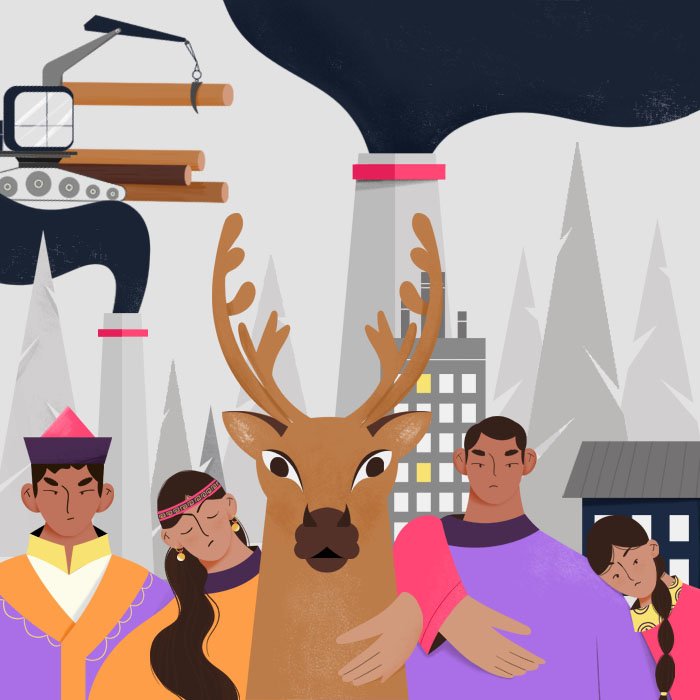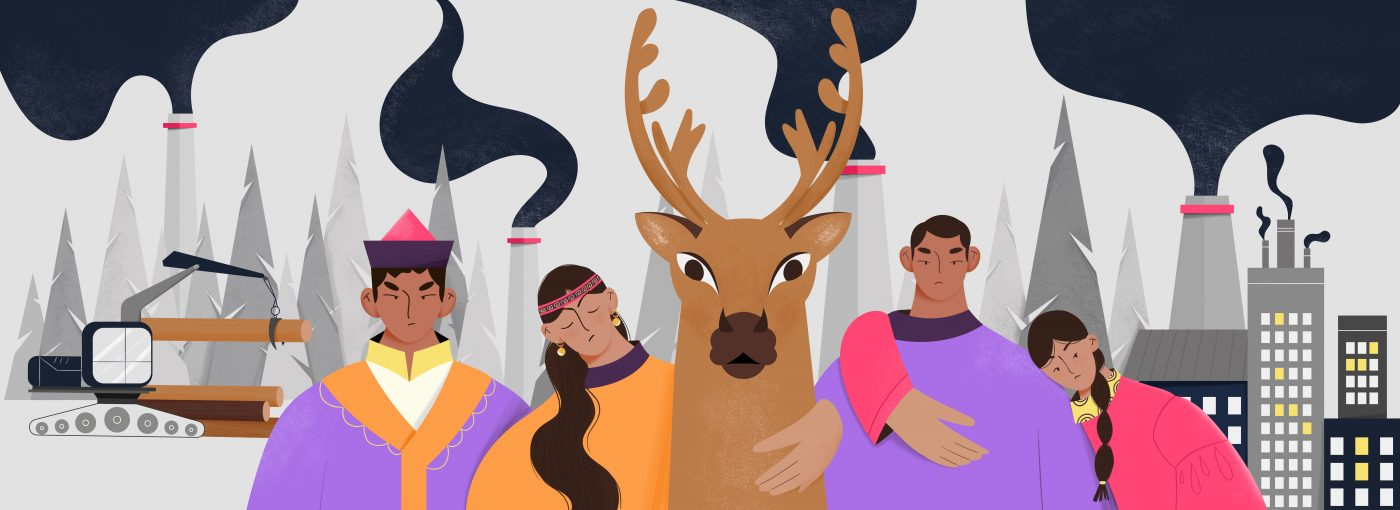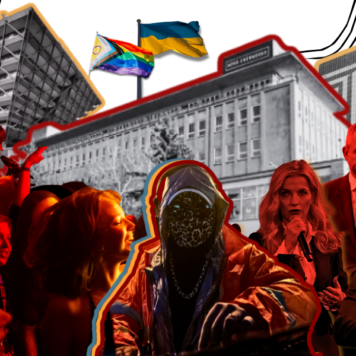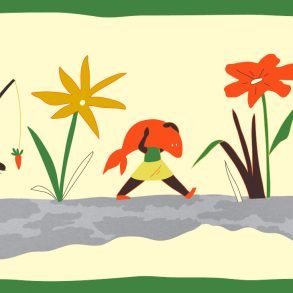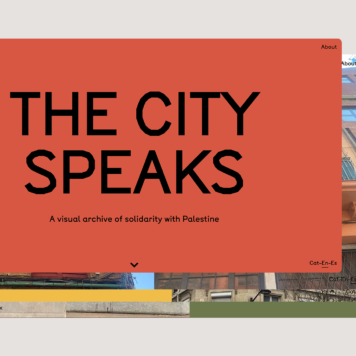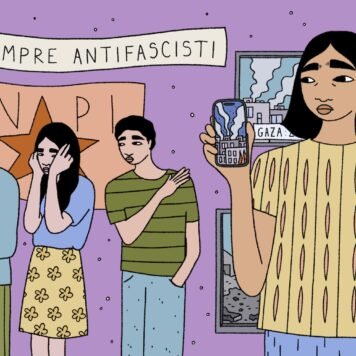When we think of Russia, we often picture the European cities of St. Petersburg and Moscow, with only a vague idea of what lies beyond. However, Russia is made up of much more than its most celebrated centres. It has a drastically diverse geography as well as various ethnicities, with 180 different peoples living in the country. Of these, 40 groups of people are officially recognised as Indigenous, including the Nenets and Dolgan people in the far North of the country, the Ulch in the Far East, and Teleuts of Western Siberia.
These Indigenous groups are linked to others all over the world by two overwhelming factors: their existence and knowledge is often overlooked at a national and global scale, and they are at the frontlines of the climate crisis.
Indigenous people are particularly susceptible to the effects of pollution, as all aspects of their lives are closely tied to their local ecosystems. If the land changes drastically, their very identity is at stake, since they rely intimately on their surroundings for not only food but their clothing, rituals, and social practices. Indigenous ways of life, already threatened by other social factors such as political marginalisation, unemployment and poverty, therefore stand to suffer the most from the destructive policies pursued by international capital and the Russian state – which have already damaged the environment in numerous ways, including extensively mining resources. The latest example of climate disruption is the raging wildfires in Siberia, which have escalated recently due to climate change inaction such as cutbacks to forest protection services.
Climate activists in Russia have been fighting to get the government to take the climate crisis seriously, as drastic weather patterns and the effects of pollution have become even more apparent – affecting everything from cancer rates to fish numbers. Forms of their activism include linking up with global movements such as Fridays For Future, with the Russian branch co-ordinating strikes and actions with its international counterparts. Regional movements such as Movement 42 in the Northern territory of Archangelsk have focused on climate education of the populace and local campaigns such as water testing, air pollution reduction and preventing the import of waste from other areas. These movements have been met with suspicion and hostility from the authorities and parts of the population, with one member of Movement 42 stating, “In the eyes of [our] society, an eco-activist is either a foreign agent or a sectarian.” Despite the heightened danger for environmental activists in Russia, the ecological awareness campaign has had some significant successes. However, there’s still a long way to go.
Despite Indigenous people bearing the brunt of the impacts of climate change in Russia, their fate and actions are all-too-often absent from the mainstream climate movement, which tends to focus on western and urbanised areas. In turn, the Indigenous people of Russia live in regions which do not dominate the news cycle of Moscow and St. Petersburg, and their plight is often underreported. This oversight becomes more harmful when you take into consideration that being an Indigenous activist in Russia is also in itself more dangerous than it is for other members of the climate movement. Indigenous homes are under an initial threat due to harmful developments like coal mining, and this threat doubles if you speak up against the destruction as local authorities may force you to flee. However, it is encouraging to learn that some Russian activists are beginning to recognise the struggles of Indigenous peoples, alongside an understanding that solutions to issues need to be centered locally and based on local knowledge which will vary along lines of ecology and ethnicity throughout the country.
The current treatment of minority groups in Russia speaks to the historical, systemic stripping away of Indigenous rights in the country. Indigenous ways of life – largely semi-nomadic and agriculture-based – are often dismissed or actively demonised by authorities, resulting in climate-related policies that damage native land. From the colonisation of Siberia by Tsarist Russia in the 16th Century and subsequent Russification of minorities, to rapid Soviet industrialisation and control of resources, the native ethnic groups of the region have not fared well under Russian leaders. The meagre attention given to Indigenous rights and education all but collapsed during the brutal neoliberal reforms of the 1990s after Soviet disintegration. This means many Indigenous people who remain on their lands have been subject to not only the industrial policy of the Russian state, but now the forces of globalised capital, with French multinational Total and British giant BP owning significant percentages of Russian oil and gas production, thus having a vested interest in developing on Indigenous lands.
In the past few years, more Indigenous people of Russia have been defending their land from threats of further destruction. In August 2020, thousands of Bashkir people and other residents of Bashkortostan near the Southern Ural Mountains formed human chains and set up camps at the foot of a mountain. They were defending the Shihan (lime mountain) Kushtau from a planned mining development which had already destroyed another shihan previously. The development was directed by the Bashkir Soda Company, who extracted limestone from the mountain, eventually hollowing it out completely. The shihans, lush and hosting a variety of wildlife, are considered unique in the geographical area dominated by steppe plains. Importantly, the mountains are also considered sacred, with local Bashkir activist Rishat Absalyamov describing a legend where the four original shihans represent the four legs on the throne of the Bashkir people. If another leg were to be destroyed, he says “The Bashkirs will generally fall as a people, [and] they will be lost.
This underscores how vital parts of the land are to Indigenous cultures. A lot of the demonstrators were arrested and beaten by police, with other locals injured and journalists’ equipment snatched by authorities. Despite this, Shihan Kushtau was finally granted protected status and the mining abandoned, thanks to the efforts of the local people, as well as allies across Russia who brought attention to the dispute and displayed their solidarity. Indigenous methods of fighting back have included taking other forms of direct action such as occupying coal loading areas and exposing local corruption.
The collective effort of Indigenous peoples in Russia to stop this upheaval gives us a glimmer of hope in an otherwise grim state of affairs. Indigenous action has included campaigning against Elon Musk’s involvement with Norlisk Nickel which pollutes Indigenous land in the Arctic and petitioning Chinese President Xi Jinping to halt the uncontrolled harvest of Russian wood from Northern Siberia to sell to China. It also includes successfully halting some of the most excessively damaging corporate projects in areas of natural beauty, including proposed hydroelectric dams near Lake Baikal. Such efforts can be viewed as a righteous example of climate justice, a fightback against environmental racism and disregard for Indigenous rights and human autonomy. Solidarity with this struggle is sorely needed – Indigenous issues are not well-known in Russia but they are precisely what require the most attention in overcoming the crisis of our age.
The highly visible climate devastation is a radicalising force for many Indigenous people. Yana Tannagasheva, from Kuzbass in the ‘coal region’ of Western Siberia, belongs to the Shor people. She was forced to flee Russia in 2018 to escape political persecution for her active opposition to mining developments, with her house being burned down by unknown assailants and her family allegedly receiving threats from the coal company which dominates the territory. A report from the Anti-Discrimination Centre found that open-pit coal mining in Siberia has inflicted “irreparable harm on the environment”, with heavy pollution, destruction of historical monuments and cultural sites, and loss of traditional economic activities – hunting and farming – for Indigenous peoples, who face blackmail and threats if they refuse to sell their homes to the corporations.
“The coal is running out, and it will run out soon. But the Indigenous peoples, the Shors and Teleuts, will remain. But they will remain among open pits, black rivers, and a decimated taiga (snow forest),” states Yana. Open-pit mines have created ‘moonscapes’ instead of rich biodiverse taiga, leaving only dirty water and the increased risk of cancer and respiratory disease for those who remain. The effects are plain to see, with coal dust creating the eerie phenomenon of black snow. Yana is now spreading awareness from outside her region, but due to the power imbalance, many Shors and other groups on the ground have no choice but to acquiesce to large coal companies.
The urbanisation of Indigenous peoples goes hand-in-hand with their native language and identity dwindling. In the Arctic and Siberian regions, traditional reindeer herders face serious challenges to their very existence – if cattle cannot possibly graze on the land, people end up leaving in search of a suitable way of life not disrupted by pollution. As one local of the coal mining area of Khakassia succinctly puts it, “People leaving this land will end up losing their culture and language, their life expectancy will drop”. This amounts to a cultural wiping out of whole peoples whose numbers are already diminishing; some Indigenous groups only have 1000 people left alive who still speak the native language. This form of environmental racism pursued by the Russian state and global capital shows a complete disregard for the safety, wellbeing and very existence of huge swathes of native people, and violates their right to self-determination.
Indigenous people are the exact demographic who should be at the forefront of preventing global warming due to their connection to and knowledge of the land. Galina Angarova, a representative of the Buryat People and Executive Director of Indigenous Rights Activist group Cultural Survival, describes her connection to the land: “I truly believe that we Indigenous peoples are key partners in land, biodiversity protection, and sustainability. We Indigenous peoples are the experts of our own environments. We carry the knowledge of our land and biodiversity in our language. Our language reflects the silhouettes of our landscapes and nature is mimicked in our sounds, in our dances, in our songs. The intimate relationship to our land and our environment is the basis of our Indigenous worldview.”
Indigenous climate activists share the same concerns and tactics of traditional environmental activists in urban areas. The only difference is that their entire lives, traditions and culture are at extreme risk due to man-made climate devastation. The well-being of all native peoples, not just in Russia but the world over, is a vital indicator of the health of our planet, and we need to do better. Indigenous people should not only have a seat at international climate negotiations but be helping to lead the movement, just as they are at the local levels, fighting for the preservation of their communities and the restoration of their land. They know the ecosystem best, and have the most at stake in its senseless destruction.
The Indigenous struggle can help us reassess our priorities and the very idea of what land is and who it is for. To reclaim stolen land is to push back against the oppressor, to harness the power of justice and solidarity in defeating capitalism’s existential rush to destroy our planet. As Galina says, “Although Indigenous people have long been excluded from the conservation movement – both physically evicted from conservation lands and politically excluded from international climate negotiations and discussions – more than ever it is being recognised that Indigenous peoples’ leadership in forest protection, traditional agriculture and knowledge of biodiversity is crucial for our continued existence as a species on this planet.”
